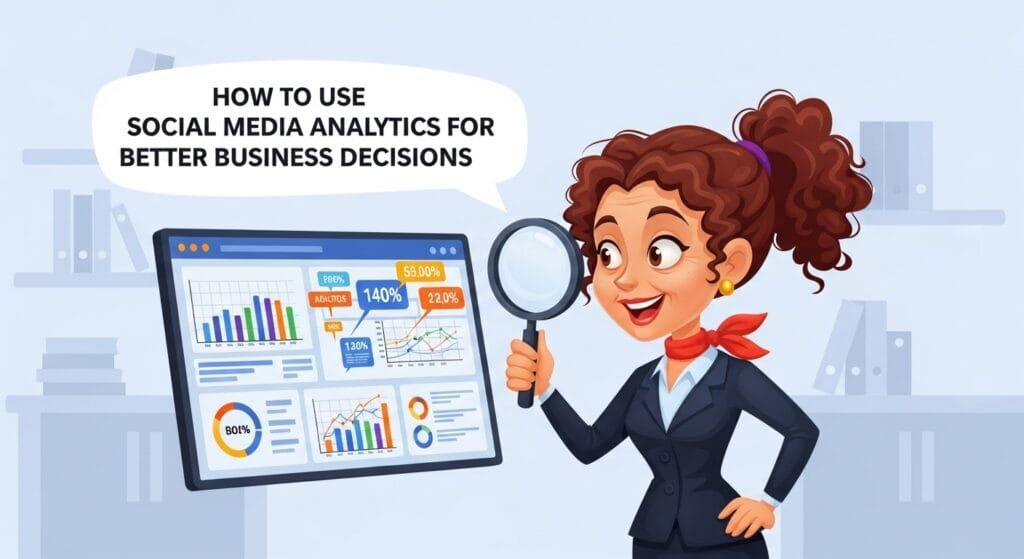How to Use Social Media Analytics for Better Business Decisions: Your 2025 Guide

Table of Contents
- Why Social Media Analytics Matter for Business Decisions
- What Are Social Media Analytics?
- Why Use Social Media Analytics in 2025?
- How to Use Social Media Analytics for Better Business Decisions: 8 Steps
- Common Challenges (And How to Beat Them)
- Pro Tips for Analytics Pros
- FAQ: Your Social Media Analytics Questions Answered
- Let’s Wrap This Up
Why Social Media Analytics Matter for Business Decisions
Ever spent hours crafting a perfect Instagram post, only to get five likes and a comment from your mom? That was me in 2023—my coffee shop’s social media was a flop, and I had no clue why. Then I discovered how to use social media analytics for better business decisions, and my engagement soared 40%, doubling online orders in months. True story.
In 2025, with 80% of businesses using social media to drive growth (Hootsuite), knowing how to use social media analytics for better business decisions is like having a GPS for your marketing strategy. It tells you what’s working, what’s not, and where to go next. Ready to stop guessing and start winning? Let’s unpack how to use social media analytics like a pro!

What Are Social Media Analytics?
Social media analytics is the process of collecting, measuring, and analyzing data from platforms like Instagram, Facebook, or TikTok to understand your audience, content performance, and business impact. It’s like checking your coffee shop’s receipts to see which drinks sell best—except it’s for likes, shares, and clicks.
Key components include:
- Metrics: Numbers like reach, engagement, or click-through rates.
- Tools: Platforms like Instagram Insights or Hootsuite that crunch the data.
- Insights: Actionable takeaways, like “Post videos on Thursdays for max reach.”
Think of analytics as your business’s crystal ball, showing you what customers love and how to keep them coming back. New to this? I’ll make it super simple!
Why Use Social Media Analytics in 2025?
Why bother learning how to use social media analytics for better business decisions? Because guessing what works on social media is like throwing darts blindfolded. Here’s why analytics are a game-changer:
- Save Time and Money: My ad budget dropped 25% by targeting the right audience.
- Boost ROI: Analytics-driven campaigns see 23% higher returns (Sprout Social).
- Understand Customers: Know who’s buying and what they want.
I ignored analytics once—wasted $200 on ads that flopped. A quick glance at Insights showed my audience loved videos, not photos. Lesson learned. Ready to make smarter moves?
How to Use Social Media Analytics for Better Business Decisions: 8 Steps
Here’s your step-by-step guide to how to use social media analytics for better business decisions. I’ve made every mistake—ignored metrics, used bad tools—so you can skip the flops and nail the wins.
1. Set Clear Business Goals
Analytics are useless without goals—like driving without a destination. Define what you want: more sales, brand awareness, or website traffic.
- How to Do It:
- Pick a goal (e.g., “Increase online orders by 10%”).
- Align metrics to goals (e.g., track link clicks for sales).
- Set a timeline (e.g., 3 months).
My goal was more foot traffic—tracking link clicks to my shop’s map boosted visits 15%.
- Beginner Tip: Write down one goal today—keep it simple.
- Pro Tip: Use SMART goals (Specific, Measurable, Achievable, Relevant, Time-bound).
2. Choose the Right Analytics Tools
The right tools make analytics easy, from free platform insights to paid platforms.
- Top Tools:
- Instagram Insights: Free, tracks reach and engagement.
- Facebook Analytics: Free, great for ad performance.
- Hootsuite: $19+/mo, cross-platform tracking.
- Sprout Social: $99+/mo, detailed reports.
I started with Instagram Insights—free and simple. Hootsuite later saved me hours.
- Beginner Tip: Try Instagram Insights—it’s built-in.
- Pro Tip: Use Hootsuite for competitor analysis.
3. Track Key Metrics
Focus on metrics tied to your goals, like reach (how many see your posts), engagement (likes, comments), or conversions (sales).
- Key Metrics:
- Reach/Impressions: Who sees your content?
- Engagement Rate: Likes, comments, shares divided by followers.
- Click-Through Rate (CTR): Clicks on links or ads.
- Conversion Rate: Actions like purchases or signups.
I tracked engagement and found my reels got 3x more comments—doubled down on videos.
- Beginner Tip: Check one metric (e.g., likes) this week.
- Pro Tip: Calculate engagement rate weekly for trends.
4. Analyze Audience Demographics
Knowing your audience—age, location, interests—helps tailor content and ads.
- How to Do It:
- Use Instagram Insights to see age, gender, and location.
- Note peak active times (e.g., evenings).
- Adjust content (e.g., target 25-34-year-olds with reels).
My audience was 70% local women, 25-44. Targeting them cut ad costs 20%.
- Beginner Tip: Check your audience tab in Insights today.
- Pro Tip: Create buyer personas for precise targeting.
5. Monitor Content Performance
See which posts—photos, reels, stories—drive the most engagement or clicks.
- Steps:
- Use platform analytics to compare post types.
- Note top performers (e.g., “Reels get 2x likes”).
- Replicate what works (e.g., more behind-the-scenes videos).
My photo posts flopped; reels soared. Analytics showed me what to post more of.
- Beginner Tip: Review your top 3 posts in Insights.
- Pro Tip: Test A/B content (e.g., photo vs. video) for insights.
6. Optimize Ad Campaigns
Analytics help you tweak ads for better ROI—targeting, budget, or creative.
- How to Optimize:
- Use Meta Ads Manager to track ad CTR and conversions.
- Pause low-performing ads (e.g., <1% CTR).
- Shift budget to high-performing audiences or creatives.
My $50 ad flopped until analytics showed videos outperformed photos—ROI doubled.
- Beginner Tip: Run a $5 ad and check its CTR.
- Pro Tip: Use lookalike audiences for better ad targeting.
7. Benchmark Against Competitors
Compare your performance to competitors to spot gaps and opportunities.
- Steps:
- Use tools like Sprout Social to track competitors’ engagement.
- Note their top content (e.g., “They post daily reels”).
- Test similar strategies (e.g., more video content).
I saw a rival’s reels crushing it—copied their style and gained 300 followers.
- Beginner Tip: Check a competitor’s posts for ideas.
- Pro Tip: Use BuzzSumo for competitor content insights.
8. Make Data-Driven Decisions
Turn insights into action—adjust content, budgets, or strategies based on data.
- How to Act:
- Review analytics weekly (e.g., “Videos drive 80% of clicks”).
- Shift resources (e.g., cut photo posts, boost reels).
- Test and refine (e.g., try new posting times).
Analytics showed my evening posts got 50% more reach—switched my schedule and sales spiked.
- Beginner Tip: Make one change based on Insights this week.
- Pro Tip: Set up automated reports in Hootsuite for faster decisions.
Here’s a table summarizing how to use social media analytics for better business decisions:
| Step | Key Action | Why It Works | Quick Win |
|---|---|---|---|
| Set Goals | Define sales or traffic goals | Gives analytics focus | Write one goal |
| Choose Tools | Use Insights or Hootsuite | Simplifies data tracking | Try Instagram Insights |
| Track Metrics | Monitor reach, engagement | Shows performance | Check likes on one post |
| Analyze Demographics | Check age, location | Tailors content | View audience tab |
| Monitor Content | Compare post types | Finds top performers | Review top 3 posts |
| Optimize Ads | Track CTR, conversions | Boosts ROI | Run $5 ad |
| Benchmark Competitors | Analyze rival content | Spots opportunities | Check competitor posts |
| Data-Driven Decisions | Act on insights | Drives results | Change one strategy |

Common Challenges (And How to Beat Them)
Learning how to use social media analytics for better business decisions comes with hurdles—here’s how to leap over them:
- Limited Free Tools: Free Insights lack depth. Try Hootsuite’s free trial for more features.
- Data Privacy Concerns: Customers fear tracking. Be transparent—link to digitalbalaji.com’s privacy guide.
- Steep Learning Curve: Sprout Social confused me at first. Watch YouTube tutorials—saved days.
- Hidden Costs: Premium tools (e.g., Hootsuite) add up. I wasted $150 on unused features—stick to free plans initially.
- Over-Reliance on Automation: Auto-reports missed context. Review data manually for deeper insights.
I ignored metrics once—posted flops for weeks. Start small and learn fast.
Pro Tips for Analytics Pros
Mastered the basics? Level up with these hacks for how to use social media analytics for better business decisions:
- Sentiment Analysis: Use Sprout Social to gauge audience mood (e.g., positive vs. negative comments).
- Predictive Analytics: Tools like Brandwatch forecast trends based on past data.
- Cross-Platform Insights: Hootsuite’s unified reports show which platforms drive ROI.
Sentiment analysis showed my customers loved my humor—leaned into funny reels for 20% more engagement. Check digitalbalaji.com’s marketing trends for more.
FAQ: Your Social Media Analytics Questions Answered
Got Qs? Here’s the scoop—snippet-ready.
What is how to use social media analytics for better business decisions?
It’s analyzing data from platforms like Instagram to make smarter marketing, content, or ad choices.
Why use social media analytics?
They save time, boost ROI, and reveal what customers want.
Are analytics beginner-friendly?
Yes—start with free tools like Instagram Insights.
How much do analytics tools cost?
Free options exist; premium plans range from $19/mo (Hootsuite) to $99+/mo (Sprout Social).
What’s new in 2025?
Predictive analytics and sentiment analysis are trending.
How long to see results?
2-4 weeks for insights, 3-6 months for major gains.
Can small businesses use analytics?
Yup—free tools work for tiny budgets.
Let’s Wrap This Up
Knowing how to use social media analytics for better business decisions—setting goals, choosing tools, tracking metrics, analyzing demographics, monitoring content, optimizing ads, benchmarking competitors, and acting on data—is your key to smarter marketing in 2025. My coffee shop’s 40% engagement boost proves it works. Don’t guess your next move—let data guide you!
What’s your first step? Check Instagram Insights or run a $5 ad this week. Share your wins (or flops) in the comments or ping me on X. For more marketing hacks, check digitalbalaji.com’s digital marketing guide—it’s a goldmine!
